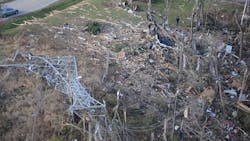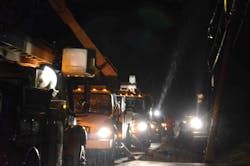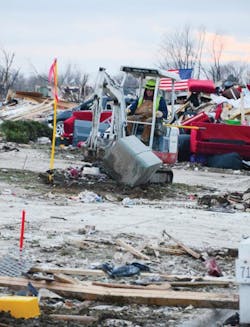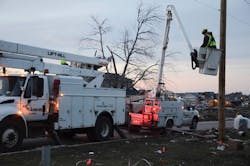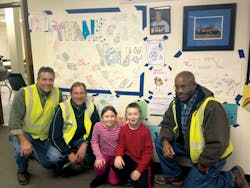Twister Destroys Illinois Infrastructure
A tornado barreled through Washington, Illinois, on Nov. 17, leveling homes and wreaking havoc on Ameren Illinois’ electric infrastructure. That weekend, the utility was on high alert status because of news of a possible severe-weather event. A tornado first touched down near one of the Ameren Illinois operating centers, and I quickly called the supervisor and asked him to run the call out list, reach out to dispatch and deploy them to the site of the destruction. The twister, which measured about a mile wide, then headed straight for my house.
As I was on the phone with the supervisor, I heard a deafening noise that sounded like rolling thunder. I walked outside, where I spotted a downed transmission tower only 250 yards from my farm. While I couldn’t make out a funnel cloud, I saw debris being sucked up into the sky out in the pasture.
My 20-year-old daughter, who was looking out the window, saw the look of terror on my face as I ran from the barn back to our house, and she quickly ran down to the basement. She said she had never seen me show any signs of fear, but that day, she knew something was terribly wrong.
Fortunately, my family and I took shelter in our basement before the tornado damaged the roof of our house. Then after a minute or two passed, the thundering noise grew silent. I walked carefully up the stairs and out the door to discover sheer destruction. Minutes before, I saw seven of my neighbors’ homes standing, but after the tornado, only a few remained. Debris was everywhere, propane tanks were blowing, transmission lines were down, and everything was missing. It was surreal and impossible to comprehend. A million things were running through my mind, and I began worrying about others in the community. At this moment, I focused on being a homeowner, neighbor and friend, and I began helping my family and community.
Helping Out the Community
To keep my family safe, I told them to stay inside while I checked on neighbors. We live about a third of a mile off a country lane, and when I walked up to the main road, I noticed that all the transmission lines were down and some of the houses were missing.
With no cell service, I had to go door to door to check on my neighbors. I also worked with my neighbors to find missing people in the community, including my neighbor Steve, who was killed by the tornado. Once we were able to provide aid to my neighbor, I was contacted by another neighbor to help remove downed conductors. I had to work with the Ameren Illinois dispatchers to clear and ground the lines to allow the paramedics access.
I then shifted gears into my role as an Ameren Illinois superintendent. I changed out of my dirty clothes into my work shirt, pants, safety vest and work boots and donned my Ameren Illinois hard hat. Three hours after the tornado hit my community, I took on my role as a crew management lead during storm restoration. Part of my roof was gone, our house didn’t have any power, and I had to hook up the generator so my wife and daughter would have power while I was out working the storm.
I left my house on a Sunday, and then on Wednesday, my family texted me that a rainstorm was coming. I then shot home, covered the holes in the roof with tarps and then went back to re-engage with the storm effort. It was challenging to try to be an effective homeowner, family member and utility field leader in the midst of all the destruction in my community.
Restoring Power
At this point, I still didn’t know the extent of damage that was done to more than 40 miles of my service territory. With no cellular service still, I called the dispatchers and all crews via a portable, and instructed them to secure the scene, work as a first responder and help get the roads cleared. We then began working through our storm-management plan through our emergency operating center.
I then learned that we lost eight sub-transmission lines, and 10 substations were completely dead at that point. More than 100 poles on multiple sub-transmission lines and 1,000 homes were affected, including the home of Bret Heavrin, a veteran Ameren Illinois troubleman. In addition to hitting my farm community, the tornado also ripped through a densely populated area, which is served primarily by underground, but it has a three-phase backbone that skirts the neighborhood.
While some tornadoes touch down, skip around and then quickly vanish back in the sky, the Illinois twister stayed on the ground, grew to a mile wide, and ran down and across the main highway. The force of the tornado relocated electrical equipment to remote locations and damaged more than 750 electric and gas meters. For example, transformers ended up three quarters of a mile away from their original location in cornfields; one even landed in a customer’s basement. The three-phase switch cabinets were ripped off their bases and moved down the street, secondary pedestals were scattered everywhere, and padmount transformers were moved four or five blocks away.
In the early phase of the restoration, we didn’t know which house belonged to which family. We had to count driveways and work our way through the debris zone. When we first started looking at our electrical equipment, it didn’t add up. Where there should have been a transformer, there was not one in sight; rather, it was three or four lots down.
During the first night, we tried to isolate and restore power to anyone who was staying in the debris and tornado zone and could receive electricity. Unlike a distribution overhead line, where you can easily see your damage and debris, isolate the taps, isolate, test and repair conductors and devices to bring your backbone hot, it was much different working on an underground system after a tornado.
The debris from the destroyed homes and cars completely covered up the electric utility devices and equipment. The crews had to identify the locations of the devices while working through tons of debris. In the middle of all of the chaos, high emotions and confusion, they had to walk through the storm zone on foot through 4 ft or 5 ft of debris.
The City of Washington, the Public Works department and the Illinois Department of Transportation used their debris removing equipment to help clear the area. Using snowplows on their trucks, the crews began digging through the debris. Ameren Illinois’ gas and electric departments also arrived with backhoes to dig for devices and scoot debris as gently as possible. Because many residents were still looking for their personal belongings, the crews had to be conscientious of the human side of the storm, as well.
When they did find their devices, they had to make sure they were still functional. While some were heavily damaged, about one-third of the devices were not cosmetically perfect, but usable. As much as possible, the linemen tried to salvage the equipment and use it to restore back to those customers whose homes were still standing. They then isolated and identified and protected the equipment that wasn’t usable.
Because of the sheer amount of destruction, Ameren Illinois called upon several contractors including Par Electric, JF Electric, Grey’s Electric, JWD, Fred Weber, Alliance Power and Miller Construction. In our area alone, we had 793 personnel between internal and contractor support from around the United States.
I worked on assessing the damage, receiving and managing all the external crews, and working with the internal crews. As the field crews came in, I served as a crew management liaison; I used the headcount and crew types to determine and assign job tasks, and to make sure they had the resources they needed to do the work.
Working Toward Recovery
Ameren Illinois is still working with the City of Washington to remove debris and rebuild the infrastructure. With winter here, the homeowners are requiring temporary service so they can plug in sump pumps and heaters, and eventually rebuild their homes.
It will take several months to rebuild the infrastructure. As for my home, we finally were able to get the roof back on our house. A lot of trees are still down, and we’re still digging through debris, but we are making progress on the restoration and rebuilding front.
Several homes and businesses were completely leveled by the tornado, including an Advance Auto Parts store that I visited 13 minutes before it was hit by the twister. Throughout the storm-restoration effort, Ameren Illinois as well as our customers were very supportive, and they made sure that we were okay and our families and homes were secure.
If I look at the big picture, I was very fortunate. Ironically, it was the first storm I’ve ever worked as a new superintendent for Ameren Illinois. Since August, I’ve been responsible to serve as a crew management leader for storm restoration, and because of this tornado, I was broken into this role very well.
I give 100% of the credit to the linemen in the field and the many people engaged in their storm-restoration roles who worked together to restore power as quickly and safely as possible to the community. Even the fellow lineman who lost his home in the tornado was out on the storm-restoration team soon after the twister hit our community.
By working together, the Ameren Illinois field workforce was able to restore power to the community and help rebuild following the twister that tore through Washington.
Steve Bergquist ([email protected]) is the superintendent of electric operations for Division 1 for Ameren Illinois. In this role, he supervises and manages the supervisors of all the operating centers for the top half of the Ameren Illinois territory.
Editor’s note: To view an online photo gallery of the destruction caused by the tornado and the rebuilding effort, visit www.tdworld.com/electric-utility-operations.
Companies mentioned:
Ameren Illinois | www.amerenillinois.com
Twitter: @AmerenIllinois
Tips for Effective Storm Response
- Develop a storm plan. Ameren Illinois assigns a role to everyone in the field during a storm-restoration effort and makes sure that the field workers know their responsibilities. Creating ownership within the team model helps everyone remain in their role.
- Run mock exercises. Before a severe storm event hits, practice this plan so it will become second nature to them during an actual emergency. If you do re-enactments of storm response throughout the year, you can critique your storm-restoration processes so you can perfect the team’s response to an emergency.
- Follow procedures. Make sure your linemen follow your Worker’s Protection Assurance process by adhering to policies for testing and grounding and lockout/tag out.
- Protect the public. In a severe storm event, all the community members want to help, and they can inadvertently put themselves in harm’s way. To keep them safe, linemen must identify hazards and work with a public safety group and wire watchers to test, ground and remove downed energized lines.
- Communicate with customers. Use as many communication channels as possible, alert them of potential weather-related outage, acknowledge awareness of the outage, update the estimated safety-restoration times with reasons and tell customers when power has been restored.
By the Numbers
- 95% of the 148,388 customers restored within 48 hours
- 912 poles
- 111 miles of cable and wire
- 1,674 crossarms
- 237 transformers
- 10,700 splices and connectors
- 70,550 hours worked on restoration (does not include any clean up)
- 773 contractors from nine companies brought in to help
- More than 1,300 work on restoration in Divisions I and IV of the Ameren Illinois service territory.
